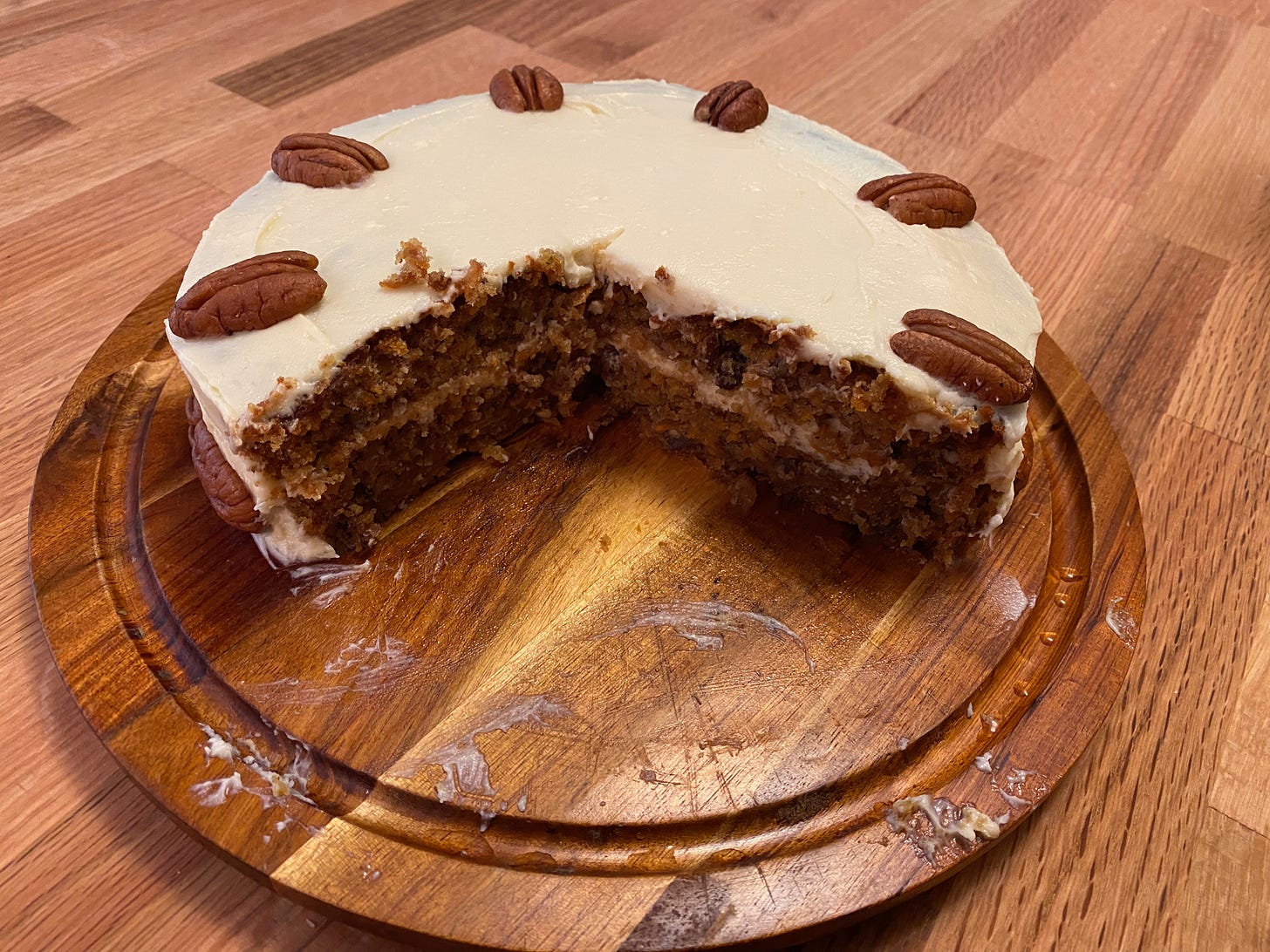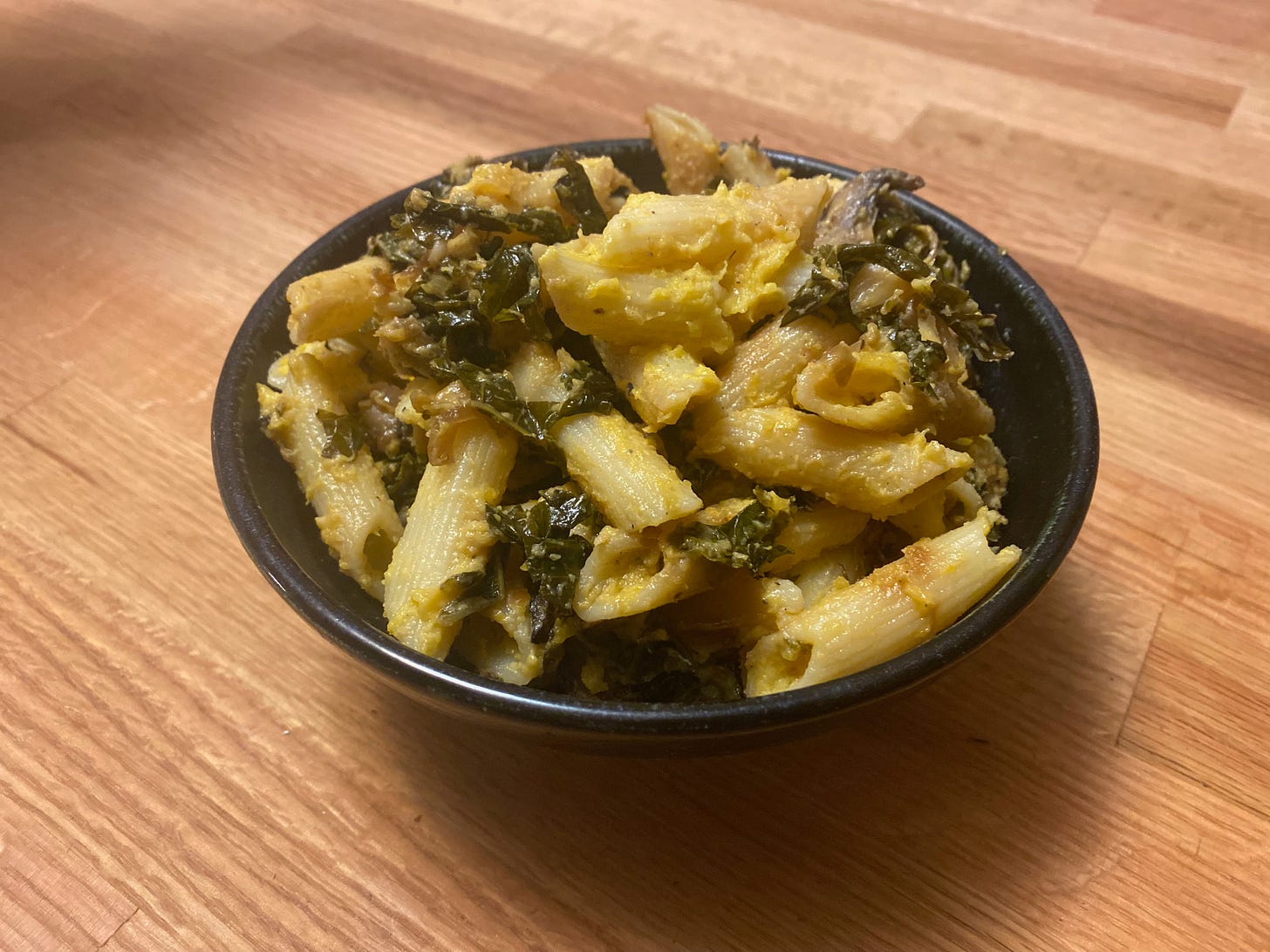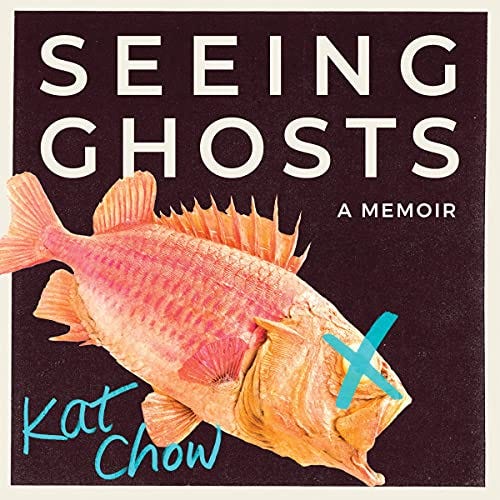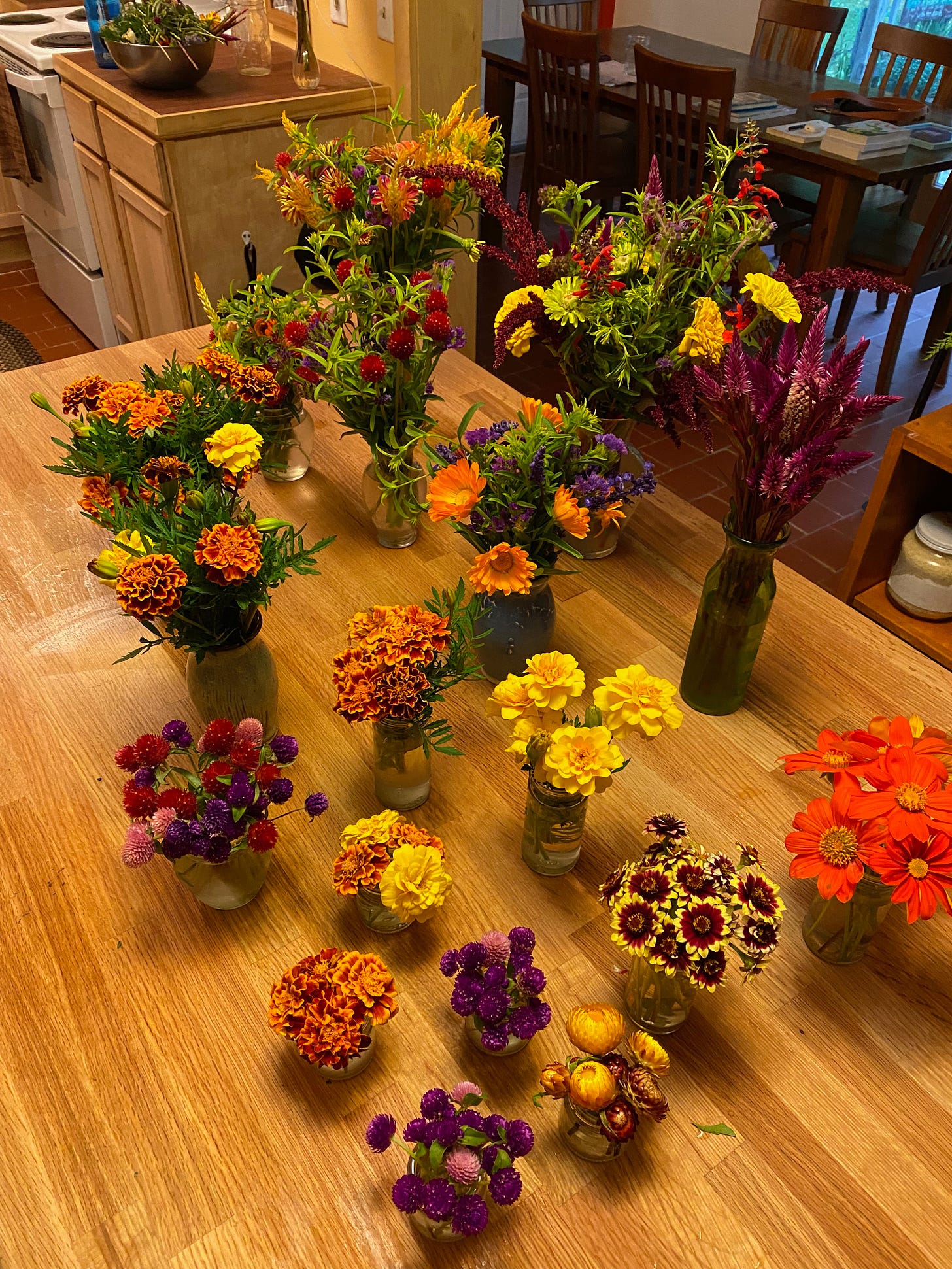Volume 1, No. 30: The Only Way to Tell the Story + One of Many Carrot Cakes
Greetings, book people! I finally hung up my bird feeder (no bear visitors yet), though most birds have yet to find it. So far I’ve seen two downy woodpeckers. I’ve missed the constant bird activity, so I’m hoping more visitors come soon!
Before I get into this week’s books: I’m planning some special editions of the newsletter for December (more on that later). I’d love to do a “Readers Ask” issue, featuring recommendations for…well, whatever books you’re looking for! Giving personalized book recs is one of my jobs, and I promise I’m good at it. So, if you’re hankering for a specific kind of book (however you want to interrupt that), reply to this email and tell me about it. If there’s enough interest, I’ll share the requests (anonymously) and my recs.
The only way to the tell the story. This is something I sometimes find myself thinking after finishing a book, particularly a strange or unusual one. There are lots of conventional ways to tell stories. And then there are stories that break all the rules of storytelling. I love those books. I love books that give me that singular feeling, that sense that there was only one way to tell this particular story, and the author found—or maybe invented—that way. How do writers come up with these beautifully odd structures? I don’t know, but every time I encounter one, I’m delighted.
The Books
Backlist: Water by the Spoonful by Quiara Alegría Hudes (Drama, 2017)
I generally try to avoid recommending more than one book by the same author, but this play is so good I couldn’t resist. (If you haven’t read My Broken Language yet, you’re in for a treat.) Most simply, this is a story about family. It’s about how we build families and who we let into our lives. It’s about the weird process of “falling into family”—how people decide to let themselves be seen, and what that means. It’s about the limits of family, but it’s also about the possibilities that arise when people break away from rigid definitions of what constitutes family in the first place.
The play is set in Philadelphia in the mid 2000s. Elliot is a twenty-something Puerto Rican man who’s just returned from the Iraq war. His mom, Odessa, is addicted to crack; she left Elliot when he was a kid and he was raised by his aunt Ginny. Odessa isn’t really in Elliot’s life anymore, but she’s started an online community for addicts and recovering addicts, and, in that virtual space, she’s a mom, a mentor, a friend.
There are two strands to the action. Part of the play follows Elliot and his cousin Yaz after the death of Elliot’s adoptive mom, Ginny. The other part is about the inhabitants of Odessa’s chat room. Orangoutang is a young recovering alcoholic who’s moved to her birth country, Japan, as part of her efforts to stay sober. Fountainhead is a recovering addict, who eventually meets Odessa in real life and ends up taking care of her when her biological family won’t. The play explores the intersecting lives of these and other characters, both on and offline.
I’ve written before about how much I love family stories. What makes this play so unique are the angles that Hudes uses to write about family. There’s a lot going on. The characters all have messy lives. It’s a plot-heavy story, and the plot is compelling. But there’s this pulse of building tension underneath the plot. At end of the play you can see exactly what Hudes was doing, where she was going. There’s an inevitability to it that feels surprising, because it feels true to life. It’s easy to look back on our lives and see how we got to where we are, but in the midst of the action, nothing ever feels inevitable.
There’s so much fascinating interplay between the kinds of families that exist in this play. Odessa has failed her son in many ways, but, in her online interactions, we see how generous and caring she is. She struggles to build a relationship with Elliot as an adult, but she’s able to create deep, lasting, and meaningful connections with her online family. The lines between physical worlds and online worlds blur. We get to see all the characters in so many different contexts. It’s a play told from so many perspectives, and that’s what makes the story work. Elliot’s experience of his mother is nothing like Orangoutang’s. Hudes peels back the layers of people, and then builds them back up, and the result is this vibrant, chaotic story about multiplicity.
Frontlist: Several People Are Typing by Calvin Kasulke (Speculative Fiction)
So there’s this new genre I’ve discovered that I absolutely love. I’m calling it Weird Queer. This book is it. It is out of control. Is it even possible to review this novel, or will I just sound ridiculous? Well, I’ll give it a try.
So, this book that takes place entirely inside Slack. I honestly have no idea how it will read if you don’t use Slack regularly, though I think it’s delightful enough that it’s worth a try. If you are familiar with Slack, I guarantee this novel will make you cackle. It’s set in the Slack channels of a small New York PR firm. Gerald is a midlevel employee who, while fiddling with a spreadsheet, somehow uploads his consciousness into Slack. Do you want me to say it again? He gets stuck inside Slack. His body remains in his apartment. It’s alive, but he can’t access it. He only exists in Slack. At first his coworkers think he’s pranking them. But he eventually convinces a few of them that no, he’s actually trapped inside Slack. His colleague Pradeep starts taking care of his body. Eventually he and Pradeep come up with a plan to get him out. Unstuck from Slack. Just so we’re all clear about how absolutely strange the setup is.
Friends, it is so weird. It’s delightfully weird and more than a little bit eerie and also hilarious. There’s a lot of office nonsense and more than a little satire. There’s a whole subplot with one of the firm’s clients, a dog food company that’s dealing with a poisoned dog food situation. There’s a woman haunted by incessant howling. Sometimes it reads like a witty office drama criticizing capitalism. In other moments, it’s more like a ghost story. Gerald does a lot of musing about the nature of consciousness.
And then there’s Slackbot. Slackbot is a major character who is at first hilarious but does not stay that way. Slackbot is a perfect metaphor for any number of things, but he’s also a fascinating character with agency. He’s got his own thing going on, his own motivations and desires. I sort of wanted a whole book about Slackbot, to be honest. It was totally enthralling rereading about the human world from the perspective of this non-human entity. If you use Slack on the regular, I promise you will never look at Slackbot the same way again.
The whole book goes off in many unexpected directions and it just keeps getting more surreal the deeper you get. If you like being disoriented, you’ll enjoy this. But it’s not the kind of disorientation that leaves you feeling cynical. Underneath all the weirdness and existential crises and technological mysteries, there is a tender queer romance. The whole book, despite its absurdity, is actually quite earnest. I often don’t like books like this, set in worlds with their own bizarre rules that it’s not always easy to figure out. Sometimes this kind of story feels too contrived, or like it’s all joke, without any heart. But this novel is nothing like that. Yes, the vehicle is specific. Yes, it’s a book that directly addresses a particular aspect of contemporary life. But it’s not really a story about Slack. It’s a story about people, and the relationships between them, and all the things that make it worth the hassle of having a body. It’s full of WTF moments, but it’s charming. It's snarky and absurd, but it’s also gentle, and most surprisingly, sweetly optimistic.
Upcoming: Madder: A Memoir in Weeds by Marco Wilkinson (Memoir, Coffee House Press, 10/12)
This is such a beautiful book about seeds, plants, family, stories, history. It’s a memoir, but it doesn’t exactly feel like a memoir. It feels more like a reckoning, or a grappling. Wilkinson grew up in Rhode Island with his Uruguayan mom and their extended family. He grew up believing the stories she told him about his dad, a man named “Donald Wilkinson”, and much of the book is him untangling these stories, trying to find the threads of truth buried beneath.
There’s one section, “Succession” in which the pages are two-toned, the bottom half black and the top half white, a visual representing soil and sky. The words are oddly spaced across the page, and I spent a long time trying to determine how to read it. I tried reading how I normally would, the left page and then the right. Then I tried reading the pages horizontally, first the white sections, and then the lower black sections. However I chose to read it, there were piece that made sense and pieces that didn’t. Sometimes the words seemed jumbled, and other times the phrases took my breath away.
Then, toward the end of the section, Wilkinson rewrites the previous pages in paragraph form, offering a kind of key. It was a relief to read those more obvious pages, and yet it also made me appreciate the previous pages more. It was like being inside his struggles and experiences. He’s writing about his mother and what she did and did not tell him about his father, and about how the ghosts of his father—real and imagined—have affected the rest of his life. It’s not easy stuff, and he makes that clear, not only in the words he uses, but in the way he places those words on the page.
Directly following the “Succession” chapter is a short chapter titled “We’d”. Like in the previous section, this one has words spaced out all across the page, like a poem. There’s no punctuation. And yet this section flows easily. It soon becomes clear that here he’s writing about his life with his partner, and their shared joys.
The juxtaposition between these two sections is startling. Both sections contain gorgeous language. But the way that language flows on the page, and the effect it has on the reader, is so different. “Because of this wound fingered, over and over again, whose edges never heal, how could she ask me to father in this world the next?” he asks in “Succession”. In “We’d” he writes: “expect the ground to ripen at our approach” and “correlate the night sky’s brightness with the depth of our shared joy”.
So much of the book feels like this, like a series of conversations. Wilkinson says so much with silence and white space. He seems to be working through the strands of his identity, his past, and his future on the page. He’s constantly interrupting himself. In several sections in which he recollects his childhood and his mother’s childhood, his memories are interspersed with the lines “This is not how any of this happened” and “You’ve got it all wrong”, always in quotes. Sometimes he attributes these quotes to his father, the ghosts, his mother, his grandparents. Other times they simply stand on their own. It’s as if, by telling the story, he’s actively figuring out how to tell the story.
I read this book slowly, over a few weeks, and I still feel like it has so much to give me. It’s full of botanical references and imagery. Wilkinson writes about his life using plants as metaphor, but he also writes about plants and gardening in beautifully concrete ways: pulling weeds from his garden, hunting for mushrooms, foraging for serviceberries. He imagines both himself and his mother as plants, drawing connections between immigration and the dispersal of seeds. But plants are only the beginning: this is a book of tangled histories. It’s about queerness and the stories we tell about queerness—to ourselves and each other. It’s about roots and ghosts. It’s about how to tell a story that’s still unfolding. What does that look like? Is it even possible? Wilkinson doesn’t provide answers. But getting to witness his thoughtful seeking is a gift.
It’s out next week, and you an preorder it here.
The Bake
There is certainly more than one way to make a carrot cake. But the friend I made this cake for said it was one of the best carrot cakes she’d ever had, and I have to agree with her. It’s based on a recipe from Flour by Joanne Chang, but it doesn’t bear much resemblance to the original.
I’m convinced the two secret ingredients that make this cake so spectacular are candied orange peel and star anise. They’re both strong flavors, but they don’t overpower the cake at all. Instead, they give it a subtle but distinct flavor that’s warm, spicy, and sweet. In a word: magical. I am extremely sad that I already finished the whole thing and can’t eat another piece right now.
The Best Carrot Cake I’ve Ever Made
I’m sure this cake will still be delicious if you make substitutions, but I can’t promise it’ll be the most delicious carrot cake you’ve ever had.
Ingredients
For the cake:
2 eggs
110 grams (1/2 cup) light brown sugar
110 grams (3/4 cup) maple sugar
3/4 cup canola oil
3 Tbs buttermilk
1 tsp vanilla
120 grams (1 cup) all-purpose flour
40 grams (1/2 cup) whole-grain spelt flour
1/2 tsp baking powder
1/2 tsp baking soda
1/2 tsp salt
1/2 tsp cinnamon
1/2 tsp ginger
1/4 tsp cardamom
1 star anise pod, ground
2 cups (260 grams) shredded carrots (about 2-3 large carrots)
80 grams candied orange peel, finely chopped
80 grams pecans, toasted and finely chopped
For the frosting:
12 ounces cream cheese, at room temperature
1 stick (1/2 cup, 114 grams) unsalted butter, at room temperature
230 grams (1 2/3 cups) powdered sugar
2-3 Tbs maple syrup
Make the cake: Preheat the oven to 350. Line an 8-inch cake pan with parchment paper and butter the the paper and sides.
In a stand mixer fitted with the whisk attachment, or with handheld beaters, beat the eggs and both sugars on medium speed until the mixture turns pale and thick. (This will take 8 minutes or more with handheld beaters.) In a small bowl, whisk together the buttermilk, oil, and vanilla. With the mixer running on low speed, pour the oil mixture into the egg mixture.
In a small bowl, combine both flours, baking soda, baking powder, salt, and spices. With a rubber spatula, fold the flour into the batter. Add the carrots, candied orange peel, and pecans. Keep mixing just until there are no visible streaks of flour left. Pour into the prepared pan, and bake for about 1 hour and 20 minutes. The top should be golden brown and spring back when you press it. Let cool completely in the pan on a wire rack.
Make the frosting: In a stand mixer fitted with the paddle attachment, beat the cream cheese until soft and smooth, about one minute. Add the butter and beat for another minute to combine. Add the powdered sugar and beat until smooth. Add maple syrup to taste, mixing after each addition, until you have a consistency and flavor you like. It’s a good idea to refrigerate the frosting for a few hours before using.
Assemble the cake: Once the cake is completely cool, remove it from the pan and split it into two layers. Place the bottom layer, cut side up, on a platter. Drop a few spoonfuls of frosting onto the layer and spread evenly, all the way to the edges. Place the second layer, cut-side down, on top. Frost the sides and top of the cake to your liking. It does not have to be pretty. You can do a crumb coat if you want. I for sure didn’t. If you want, decorate with pecan halves.
It’ll last for a week or so in the fridge. Take it out a few hours before you want to eat it.
The Bowl and The Beat
The Bowl: Classic Fall Butternut Squash Pasta
This is a go-to fall dish for me. It’s not especially inspired, but it’s tasty and simple. I make a sauce with roasted butternut, toss it with pasta, and then just sauté whatever veggies I have around. This time I used onions, kale, and mushrooms, but you could just as easily use any other green, or sweet peppers, or leeks and apples…or basically anything else.
Cut a butternut squash in half lengthwise and scoop out the seeds. Put it on a baking pan and drizzle with some olive oil. I like to cut the tops off a few heads of garlic and add those to the pan as well. Roast at 425 for 45 minutes or so, until both the squash and the garlic are soft. Let cool. Peel away the skin and scoop the squash into a bowl. Squeeze the garlic out of its skin and add that. Add a few big scoops of goat cheese (or ricotta, or feta if you want something tangy), a few glugs of olive oil, and salt and pepper. I like to mix it with an immersion blender to get it nice and smooth, but you can also just mash it with a fork.
While the squash is roasting, slice an onion or three. Sauté them until they’re nice and soft. Add some sliced mushrooms. When they’re nicely browned, add a whole bunch of chopped kale. Cook for a minute and then add a splash of sherry vinegar. Keep cooking until all the liquid evaporates. Toss the sauce with your favorite pasta and add the veggies on top. Yum.
The Beat: Seeing Ghosts by Kat Chow, read by the author
This is a memoir about grief and family memory. It’s about the death of Chow’s mother, but it’s also about family history. Some sections are written in the second person, addressed directly to her mother, and others aren’t. I really like the mix. I always enjoy memoirs that are messy and nonlinear, and so far I’m really enjoying this one. Chow writes about her relationship with her mother, father, and sisters, but she’s also interested in where her parents came from, and how their stories have shaped her life. So the book is full of stories of Chow’s childhood, her parents’ meeting and early marriage, her grandparents’ lives in China and Hong Kong. Some of these stories are ones that Chow herself has lived. Others she gleams from conversations with her parents. Others she imagines, extrapolating from the little she does know. It’s such a moving way to explore the legacy of someone’s life and death.
The Bookshelf
Now Out
Hooray! Between Certain Death and a Possible Future by Mattilda Bernstein Sycamore is now out! Go forth and find yourself a copy.
Around the Internet
On Book Riot, I made a list of 20 must-read adult novels by trans and genderqueer authors from 2021. On Audiofile, I wrote about three amazing audiobooks that feature monsters.
The Boost
Need more book recs? Probably not, but my Book Riot colleague Cassie just launched a newsletter recommending under the radar books, and I’m sure it’s going to be great.
As always, a little bit of beauty to send you on your way: We’re going to get a frost one of these days, and I’m going to rejoice. In the meantime, I’m reveling in flowers.
And that’s it until next week. Catch you then!








